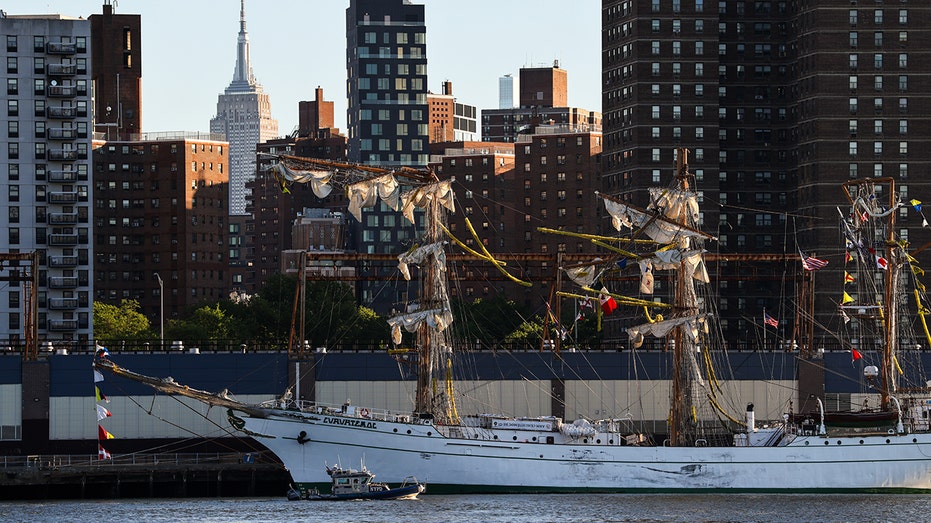In a recent development regarding the incident involving the Mexican Navy tall ship that crashed into the iconic Brooklyn Bridge, the chief of Mexico’s Navy has clarified the situation surrounding the ill-fated maritime operation. This statement comes as concerns over safety protocols and communication procedures grow, particularly following an event that has captured significant media attention.
The tall ship in question, known for its impressive stature and historical significance, was conducting a routine voyage which suddenly turned disastrous. Eyewitnesses reported seeing the vessel striking the bridge at the heart of New York City, raising alarms and prompting immediate responses from various emergency services in the area.
Despite the dramatic nature of the crash, Navy Chief Admiral José Rafael Ojeda Durán has stated that no distress calls were made from the ship before or during the incident. This particular revelation has sparked debate over the circumstances leading to the crash and whether proper maritime procedures were followed.
The lack of emergency communication raises pressing questions about the protocols that personnel aboard the Mexican Navy vessel adhered to prior to the incident. The Admiral’s remarks suggest a need for a comprehensive investigation to better understand the tragic circumstances and prevent similar occurrences in the future.
Admiral Ojeda Durán commented during a press conference that the vessel was operating under standard navigation conditions at the time of the incident. He emphasized that a thorough investigation would be conducted to piece together the events leading up to the crash. “Investigative teams are already in place,” he assured reporters. “We will explore every avenue to uncover the causes and ensure accountability.”
While details surrounding the collision are still emerging, reports indicate that the ship’s crew faced a series of significant challenges. With navigational equipment and communication systems in place, the failure to issue a distress call adds another layer of complexity to the investigation. Observers have speculated if this failure could stem from human error, equipment malfunction, or a combination of both.
The Brooklyn Bridge, an iconic structure that connects Manhattan and Brooklyn, is a focal point not just in New York City but across the globe. Its historical and architectural significance makes it a prime target for tourists and locals alike. The incident has raised concerns over safety, particularly regarding maritime operations in heavily trafficked urban areas.
As the city recovers from the shock of the incident, many residents have expressed concerns about the implications for both naval and civil operations in the area. The Brooklyn Bridge, a vital transportation artery, faced temporary closures as authorities worked to assess the structural integrity following the collision.
Experts in maritime law and safety have commented on the situation, highlighting the importance of immediate communication protocols in ensuring the safety of vessels and structures alike. “Emergency communication is fundamental in preventing disasters,” remarked maritime safety analyst Dr. Laura Escobar. “A failure to communicate under dire circumstances could have massive implications for crew safety and structural integrity.”
This incident marks a unique moment in the relationship between the Mexican Navy and U.S. authorities, as the consequences of the crash could have far-reaching impacts on future naval excursions in U.S. waters. Admiral Ojeda Durán assured that cooperation with U.S. naval agencies will be a critical component in the investigation moving forward.
In a related development, the Mexican government has expressed its commitment to transparency throughout the investigation. Officials have pledged to keep the public informed as details arise. The Ministry of Foreign Affairs announced that it would release periodic updates to ensure that families of those affected remain informed during the ongoing evaluation of the events.
Many individuals in the Mexican Navy community and beyond have rallied together to support those affected by the crash. Several non-profit organizations have begun initiatives aimed at raising funds and awareness for the families of the crew members aboard the tall ship. Community leaders have underscored the importance of unity in such trying times.
On the media front, extensive coverage of the incident has led to a surge of discourse regarding maritime safety protocols and the significance of timely communication. As the investigation proceeds, it is expected that lessons learned from this event will act as benchmarks for future maritime operations and safety regulations not only in the United States but also internationally.
As this tragic narrative unfolds, it reflects broader themes in the realm of maritime safety and liability. The absence of a distress call has highlighted the importance of efficient communication systems across maritime vessels worldwide. These systems, when functioning properly, serve as lifelines during emergencies, guiding immediate response actions and ensuring the safe navigation of waterways.
In anticipation of forthcoming findings, the public remains vigilant, scrutinizing procedures and responses following alarming events on the water. Reports indicate that safety standards will likely be revisited to upgrade current protocols in light of the incident, with industry experts advocating for stronger regulations governing naval operations in urban environments.
As the U.S. Coast Guard and other agencies continue to analyze the accident, one cannot underestimate the consequences it may have on future ship activities near critical structures. Policymakers and naval strategists concur that this event will generate discussions around maritime safety at both national and international levels, re-evaluating how naval operations are conducted in shared spaces like the bustling New York Harbor.
In closing, the collision of the Mexican Navy tall ship with the Brooklyn Bridge has raised significant questions about navigational safety, communication failings, and emergency response protocols on maritime vessels. Moving forward, as the investigation uncovers more details, it is crucial to address these gaps to foster a safer environment for both naval operations and urban infrastructure. Only then can both the Navy and the City of New York work toward preventing such incidents in the future, ensuring that safety remains paramount in their operations.
































